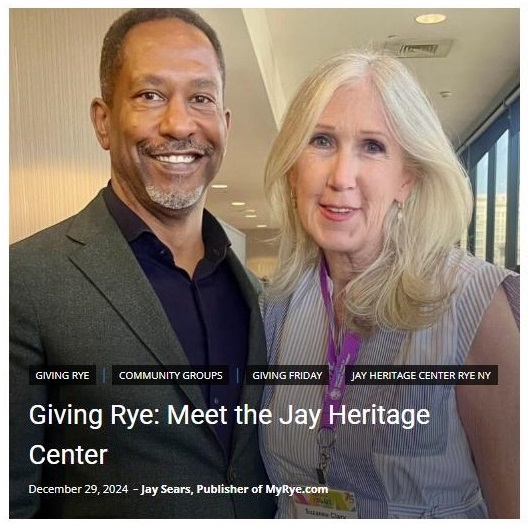The Jay Estate in Rye was home to one of our nation's greatest peacemakers, John Jay...
...and today, it is YOUR park
Our nonprofit, the Jay Heritage Center (JHC) is dedicated to transforming the 23-acre Jay Estate into a vibrant educational campus, hosting innovative and inclusive programs about American History, Historic Preservation, Social Justice, and Environmental Stewardship.
Read About Top Accomplishments Too!

Giving Rye Column Highlights 2025 Plans
Suzanne Clary with Brent Leggs, executive director of the African American Cultural Heritage Action Fund and SVP of the National Trust for Historic Preservation Senior Vice President at the 75th anniversary of the National Trust for Historic Preservation.
Thank you to Jay Sears and the My Rye team for the opportunity to talk about JHC’s year in review and share what lies ahead in 2025! Giving Rye is a feature series highlighting nonprofit and community groups in and around the City of Rye.
Find out what our top initiatives will be in the coming year. Who are our biggest supporters? How can you and your family get more involved? What’s welding got to do with it? READ MORE HERE.
Arts & Culture App Expands Access

Bloomberg Philanthropy Highlights Jay Estate
Support comes in many different ways including the acknowledgement that what we’re doing is mirroring what’s happening at some of the most innovative and inspiring institutions in the world.
Bloomberg Philanthropies has long been committed to helping arts and culture organizations enrich their communities. They believe technology opens doors, and created an app called Bloomberg Connects as a part of their mission to make the arts and culture accessible to all – in-person or at-home. And now the Jay Estate is one of 650 museums, galleries, gardens, and cultural spaces that you can access anywhere for FREE. We are both humbled and energized to have been selected! Download the app today!
HELP US HOST BUILD OUR CAPACITY!

From lectures on American History to outdoor art exhibits and modern dance to family-friendly concerts on the lawn and garden workshops, your annual gift makes SO much possible! Donations also help fund our staff and operating expenses so we can make your experience at our park the best it can be!DONATE HERE
|
|
|
Land Acknowledgement
It is with gratitude and humility that we acknowledge that we are learning, speaking and gathering on the land of the Wiechquaesgeck (WE-QUEES-GECK), a subdivision of the Munsee people. The Munsee can be identified as speakers of Munsee, a dialect of the Lenape language. Today, the Munsee language is considered critically endangered, only spoken by a handful of elders on the Moraviantown Reserve in Ontario, Canada, each speaker over the age of 70. Lenape, or Leni Lenape was a name prescribed to them by colonists, rather than a label of initial self identification.
The Wiechquaesgeck were the historic owners of Rye, Harrison, and large parts of Westchester County, as they lived between the Hudson and Long Island Sound. Modern nations like the Stockbridge-Munsee, the Delaware Tribe of Indians, and the Delaware Nation trace their ancestry to the Munsee tribes, and continue to keep their history alive. We pay honor and respect to their ancestors past and present as we commit to building a more inclusive and equitable space for all. In the coming years, we plan to reintroduce species of fauna and flora indigenous to the Wiechquaesgeck into our gardens as a way to promote greater respect and understanding of their culture.
We Value Your Privacy
JHC Privacy Policy
